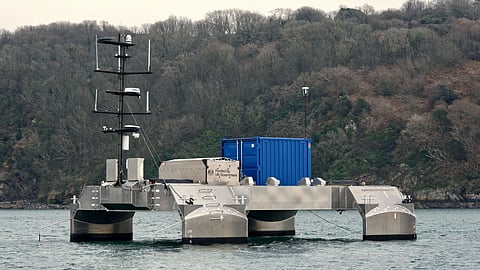VESSEL REVIEW | USV Pioneer – Autonomous SWATH demonstrator with hybrid electric and hydrogen propulsion
UK unmanned systems company ACUA Ocean recently unveiled a new autonomous unmanned surface vehicle (USV).
The 14.2-metre (46.6-foot) long, 25GT USV Pioneer is the first vessel in a new series of USVs known as the Pioneer-class. The lead USV was built by Isle of Wight-based Aluminium Marine Consultants to a design developed by naval architect John Kecsmar of Ad Hoc Marine Design.
With stability similar to that of larger monohulls
ACUA Ocean said the key to the design of USV Pioneer is its unique SWATH design, which provides for significantly enhanced stability in higher sea states. Research conducted by the University of Southampton, including wave tank testing and digital simulations, show the Pioneer-class USV outperforming the seakeeping stability of a monohull vessel three times its length and 10 times its displacement.
ACUA Ocean said the craft’s platform stability, payload versatility, portability and scalability meet the need of end users for high-quality data and operational availability and reliability in open ocean conditions but delivered at a fraction of the cost of larger crewed or autonomous platforms.
The USV also boasts a maximum endurance of 40 days, meaning increased operational time on site and for data collection. Power is provided by RAD Propulsion 40kW electric twin drives that allow clean and efficient control by third party systems.
The craft was developed to meet the increasing need to rapidly deploy the latest equipment and technology rather than multi-year procurement and build cycles of traditional vessels, while also bringing greater seakeeping stability and operational persistence not currently found in smaller monohull USVs capable of collecting data and deploying sensor and system payloads.
Increasing scope of autonomous operation
Robosys Automation’s AI vessel control software has been integrated into the USV’s hybrid electric and hydrogen propulsion systems. Thanks to the software, the craft is capable of managing both itself and its onboard safety critical systems.
The USV will be supported by a dedicated remote operator who will be constantly monitoring the craft’s missions and who can fully override any controls and systems whenever required.
Robosys’ control system features an OEM-recommended computing unit, which allows the considerable onboard control architecture to be efficiently handled with built-in failsafes. As the system is also industry-agnostic, the software can be integrated with electric, petrol, diesel and hydrogen propulsion and ancillary systems.
The software facilitates full vessel control of the USV via ACUA Ocean’s shore-based remote operations centre in Plymouth or a mothership. Initially designed to conform with Level 3 Autonomy, the USV can swiftly ramp up to full Level 4 autonomy in the future using the AI vessel control software.
USV Pioneer has just completed undergoing a three-month period of sea trials and will now be prepared for demonstrations. The craft can be used for open ocean monitoring and data collection across the security, offshore energy, and marine conservation sectors.


